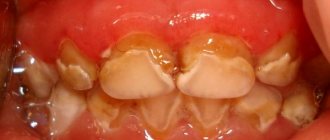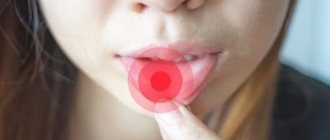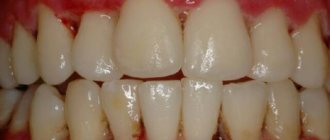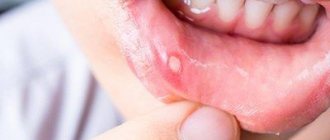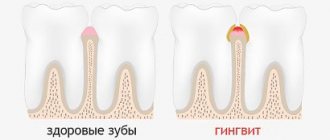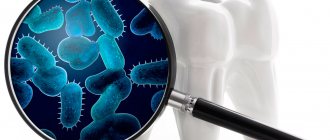Gingivitis is a periodontal disease accompanied by inflammation of the marginal part of the gums (tissue swelling, pronounced hyperemia). In children, the occurrence and development of the disease is associated with the active occurrence of biological processes in periodontal tissues: teething, bite formation, and root formation. During puberty, in most cases, gingivitis is a consequence of hormonal changes in the body.
Important. The disease is common, occurring in approximately 2% of children aged 2-4 years; in older children, the diagnosis rate is much higher.
Causes of gingivitis in children
80-90% of cases of the disease in children are associated with the accumulation of dental plaque, which is an ideal environment for the proliferation of pathogenic microflora. The more dental plaque there is and the older it is, the greater the number of bacteria that develop in it. One day without oral hygiene is enough for the first signs of the disease to appear. Treatment of gingivitis in this case comes down to professional hygiene - removing stones and plaque.
Predisposing factors also include uneven load on the child’s periodontal complex. This may be due to an incorrect bite, crowded teeth, tooth decay or poorly fitting fillings. The appearance of gingivitis in children can be caused by injury to the gums (for example, while brushing teeth), or as a result of burns from hot food.
In some patients, acute gingivitis occurs against the background of teething or changing teeth. The gums become inflamed at this time, acquiring a characteristic bright red color. Puberty is also a risk factor.
In some cases, gingivitis can develop against the background of past infections or systemic diseases that weaken the immune system. Diabetes mellitus, heart disease and thyroid disease predispose to the onset of the disease.
Why is inflammation of the gums near the teeth dangerous?
Childhood gingivitis develops very quickly, since there are many prerequisites for this - from child abuse of sweets to insufficient oral hygiene. After the start of the process, the volume of actively multiplying pathogenic microflora quickly increases. On the second or third day, you can already notice the first signs of beginning mucosal erosion. If you do not seek help at this time and start the disease, the already matured child will suffer from gum problems all his life and may lose his teeth prematurely.
Symptoms of gingivitis in children
Common symptoms of gingivitis in children include swelling of the gums, congestion (fullness of the blood vessels with blood), and pain in the mouth. In the advanced form, fever and general malaise are associated. Also a common feature for all varieties is poor oral hygiene.
Quite often, stomatitis (gingivostomatitis) is associated with gingivitis. In this case, not only the gums suffer, but also the entire oral mucosa. The child experiences constant pain, itching, burning, and becomes capricious and uncontrollable.
Viral gingivitis is especially dangerous against the background of a herpes infection, quickly turning into an ulcerative form. Young children are most susceptible to it. A one-year-old child, due to his age, pulls all objects into his mouth, thereby creating a favorable environment for the development of pathogenic bacteria.
Why do gums become inflamed?
The main cause of inflammation is the same in both adults and children - poor oral hygiene, that is, insufficient quality of teeth cleaning. In children, additional factors also play a significant role:
- In the youngest children, gingivitis occurs during teething;
- the cause may be malocclusion in children, causing uneven distribution of the chewing load;
- gums become inflamed due to a lack of vitamins and minerals in the child’s body;
- inflammation is provoked by advanced caries and its unprofessional treatment - in particular, incorrectly installed fillings that constantly injure the mucous membrane;
- the presence of chronic diseases also affects;
- Children with weakened immune systems suffer from gingivitis.
Conventionally, gingivitis that occurs during the eruption of primary or permanent teeth and the formation of dental roots can be called a physiological norm. In all other cases, professional diagnosis and consultation with other medical specialists are necessary to help identify the cause of gum inflammation in children and carry out effective treatment.
Types of gingivitis
The disease can progress differently, depending on the type of gingivitis. Treatment is prescribed by a doctor individually in each specific case.
Important. The acute form of the disease is much more common in children. The chronic form occurs in the absence of treatment.
Classification
The disease is classified according to several criteria:
- zone of distribution - local (one interdental papilla is inflamed) or generalized (most of the gum is inflamed) gingivitis;
- nature of the course - acute or chronic stage;
- the degree of change in the mucous membrane of the gums - catarrhal, ulcerative, hypertrophic, atrophic, marginal, desquamative.
According to the severity of the disease, three forms are distinguished - mild (damage to one or two interdental papillae), moderate (inflammation of the gum edge), severe (damage to most of the gum).
Catarrhal
Acute catarrhal gingivitis is most often diagnosed during teething or changing teeth, as well as against the background of previous infectious diseases.
Characteristic features:
- severe redness and swelling of the affected areas;
- discomfort in the gums, pain, itching, bleeding of the gums when brushing teeth or eating;
- bad breath;
- low-grade fever.
There is a feeling of malaise, but the general condition is not cause for concern.
Marginal
It usually occurs in childhood and indicates poor oral hygiene. It goes away immediately in a chronic form, another name for the disease is “dirty” gingivitis. It manifests itself in bleeding gums, usually when brushing your teeth. The marginal tissues are swollen, hyperemic, with a cyanotic tint. Treatment consists of removing plaque and following oral hygiene rules.
Desquamative
The main feature of desquamative gingivitis is epithelial sloughing. The affected areas are also distinguished by increased redness in the form of individual spots. In the initial stage, the disease does not cause concern, but later, in the absence of treatment, the mucous membrane becomes loose, pain and burning in the gums appear, and erythema spots grow. When neglected, blisters with yellowish contents appear in place of the spots, then ulcers form in place of the blisters. At the same time, sleep is disturbed, headaches and irritability appear.
Important. Desquamative gingivitis occurs cyclically with sudden exacerbation without provoking factors. Remission is long-term, up to two years.
Hypertrophic
The second name is hyperplastic. The disease is typical for prepubertal and pubertal age and is associated with the influence of sex hormones on gum tissue at this particular age. In the fibrous form, there is an overgrowth of the papillae, the gums are greatly enlarged and partially cover the teeth. The edematous form is more severe - the gums are enlarged and hyperemic. When brushing your teeth and chewing food, the pain and bleeding noticeably intensify.
A dental examination reveals severe gum overgrowth, looseness and swelling of the gingival papillae, and the presence of false gum pockets. Also, a distinctive feature of hypertrophic gingivitis is a significant amount of plaque on the teeth.
Ulcerative
The ulcerative form is the next stage of catarrhal gingivitis against the background of decreased immunity after influenza, acute respiratory viral infections, infectious diseases, and herpetic stomatitis. Another reason is hypothermia.
Characteristic symptoms:
- hyperemia, swelling, bleeding gums;
- the appearance of ulcers;
- general weakness, low-grade fever;
- bluish tint near the gums.
In the absence of adequate therapy, the disease passes into the ulcerative-necrotic stage - the ulcers are covered with a gray-green coating, a putrid odor from the mouth appears, and saliva becomes viscous. Sleep and appetite disturbances are observed, the child becomes capricious.
Atrophic
In most cases, the disease is chronic and is detected during examination by a dentist. It is observed in case of improper filling of teeth, in the presence of congenital defects of the frenulum of the tongue, or in case of malocclusion.
Symptoms – not clearly expressed:
- slight bleeding gums;
- exposure of tooth roots;
- reduction in gum volume.
In the initial stage, there are no inflammatory signs or pain, the gums are not hyperemic. Then, with the gradual exposure of the roots of the teeth, discomfort and pain appear when eating hot or cold food. In the absence of treatment, progressive dystrophic changes in the gingival margin are observed.
What is pathology
Gingivitis is an inflammatory pathology of the gums, in which there is no damage to the periodontal junction or other periodontal tissues (tissue surrounding the tooth). If treatment does not occur for a long time, then damage to these structures, called periodontitis, may occur. Most often in children, the marginal part of the gum, located next to the dental neck, is affected.
The inflammatory process is promoted by:
- high activity of biological processes in gum tissue;
- formation of the dental system;
- unformed local immunity.
Most often, gingivitis is detected in a child aged 2–4 years, as well as in one-year-old babies during teething.
How to treat gingivitis in children
Gingivitis is a disease with a favorable prognosis. Accurate adherence to the doctor’s recommendations makes it possible to fully recover and eliminate future relapses.
Treatment always begins with sanitation of the oral cavity. Removing tartar and soft plaque is mandatory, since deposits are a source of infection. For young children, cleansing is carried out using special brushes, for older children (after 10 years) - using ultrasound. After cleansing, the doctor prescribes rinsing with anti-inflammatory agents twice a day (in pharmaceutical form or decoctions of chamomile, sage, mint, eucalyptus).
Important. Dear parents. It is not possible to cure the disease with folk remedies alone. By neglecting this rule, you risk aggravating your child's condition.
When treating gingivitis, the doctor uses an integrated approach, taking into account the individual characteristics of the child. Carious cavities are removed, and fillings with overhanging edges or poor polishing are replaced. If there is a congenital malocclusion or tongue frenulum, the necessary manipulations are performed. At a certain stage, consultations with narrow specialists may be required - a dental surgeon, an orthopedic dentist, a therapist, an endocrinologist, a cardiologist.
If necessary, the doctor prescribes intraoral electrophoresis, laser therapy, massage, and ultraviolet radiation. At an advanced stage of the disease, antibiotics are necessary. In severe cases, when conservative therapy is unsuccessful, surgery may be required.
The most important role in the treatment of gingivitis in children is played by vitamin therapy and proper nutrition. It is necessary to create a diet in such a way that you use foods high in vitamins for cooking.
Important. During treatment, you need to ensure that the food is ground or soft. Parents are required to ensure that the eating process causes as little discomfort as possible.
Diagnostics
The diagnosis of gingivitis is established by a pediatric dentist or periodontist based on an examination of the oral cavity, due to the characteristic clinic. All forms of pathology have characteristic signs.
They are:
- the presence of soft deposits or tartar;
- the presence of gum inflammation;
- there are no gum pockets;
- dentogingival connections are preserved.
X-rays are performed to confirm the diagnosis. Changes in the jaws are not detected. Numerous concomitant diseases are detected (malocclusions, caries, abnormal attachment of the frenulum of the lips and tongue), filling defects. To find the causes of the pathology, consultations with a cardiologist, endocrinologist, or therapist are prescribed.
Medicines for gingivitis
The medications your child needs are prescribed only by a doctor, based on the clinical picture of the disease and the individual condition of your child. Self-medication in this case is unacceptable, as it can lead to significant complications, including osteoporosis of bone tissue.
What to smear
Gels and ointments are applied after rinsing the mouth. The surfaces are pre-dried with a cotton swab or gauze.
Holisal.
The gel has a good anti-inflammatory and analgesic effect. Apply three times a day to the affected areas of the gums.
Apident active.
An ointment based on natural ingredients that quickly relieves pain and inflammation. The composition is applied to the inflamed areas and rubbed in with gentle circular movements.
Solcoseryl.
Used to heal bleeding areas, the gel is applied to both sides of the gums. Use as prescribed by a doctor.
Asepta gel.
Mainly prescribed for the treatment of chronic gingivitis. The drug relieves inflammation, pain, and itching well. Apply 2-3 times a day depending on the severity of the condition.
How to rinse
Important. Alcohol tinctures should not be used for rinsing, as their use will lead to even greater irritation.
Rinsing is mandatory when carrying out anti-inflammatory therapy. Carry out after each meal and additionally throughout the day. For young children, parents apply applications using cotton swabs soaked in solutions. In severe cases, treatment of the oral cavity and gums is carried out in the dental office.
For rinsing the following is prescribed:
- Chlorhexidine 0.05%.
Use after every meal. Rinse your mouth vigorously for 30 seconds. - Furacilin.
Use a ready-made 0.02% rinse aid or dissolve one tablet in a glass of boiled water. The drug disinfects the oral cavity well. - Furamistin 0.01%.
It has a powerful antibacterial effect and is used after meals. - Herbal infusions.
Prepare at home in accordance with doctor's recommendations.
Important. Before using solutions, rinse your mouth with clean water to remove any remaining food.
Antibiotics
In the chronic stage and in severe forms of the disease (ulcerative, ulcerative-necrotic), as well as in cases of high risk of complications, antibiotics are prescribed. The doctor selects the drug and dosage individually.
Folk remedies
Traditional methods are based on the specific properties of plants, decoctions of which have a good anti-inflammatory effect.
Sage.
Pour two tablespoons of the herb into 0.5 liters of boiling water, boil for 10-15 minutes, leave for an hour. Rinse your mouth 2-3 times a day. The decoction relieves inflammation well and reduces bleeding gums.
Pine needles.
Pour 1-2 tablespoons of needles into a glass of hot water, bring to a boil, leave for 40 minutes. Use 3-4 times a day. The infusion has a strong antimicrobial effect.
Aloe.
Chew peeled and well-washed leaves several times a day.
Pharmaceutical camomile.
Take chamomile flowers and linden flowers in equal proportions. Pour boiling water over tablespoons of the mixture, boil for 20 minutes, and let steep for half an hour. The infusion has a pronounced anti-inflammatory effect. Apply three times a day.
Herbal collection
(mix oregano, St. John's wort, peppermint in a ratio of 1:1:2). Pour three tablespoons of the mixture into 1.5 cups of boiling water and simmer for another 30 minutes. Leave for two hours, rinse three times a day. The decoction helps relieve inflammation and pain, eliminates bleeding and bad breath.
Clinical manifestations of the disease
Each of the clinical forms has its own typical manifestations and features of the course of the disease.
The following symptoms of gingivitis in children are distinguished:
- Catarrhal - this form appears in babies at the time of teething (by 1 year) or their change. They experience swelling and soreness of the mucous membrane. They intensify when eating spicy and hot foods. There is also bleeding, itching of the mucous membranes, and bad breath. Upon examination, a loose, thickened mucous membrane is revealed, its color changes to purple with a bluish tint. Low-grade fever and general malaise are noted.
- Hypertrophic – refers to chronic forms. It is divided into edematous and fibrous. The edematous form is manifested by swelling, bleeding, itching, and pain. Fibrous tissue is characterized by a pronounced proliferation of gingival tissue. Upon examination, gum hypertrophy is revealed, it hangs over the crown, partially covering it. The mucous membrane is loose, edematous, and false gum pockets are formed. There is plaque in large quantities. This option is more common in teenagers.
- Ulcerative – is a complication of catarrhal gingivitis. It is characterized by ulcers on the mucous membrane, covered with a grayish-greenish coating. There is an increased viscosity of saliva. The patient's mouth has a putrid, unpleasant odor. There is a deterioration in the general condition, there are signs of general intoxication, decreased appetite, and disturbed sleep.
- Atrophic – its development is possible due to defects in orthodontic treatment, anomalies in the location of the frenulum. There are no signs of inflammation. Dystrophy of the gingival tissue progresses, and the necks of the teeth are exposed. There is an increase in reaction to temperature changes.
With all these forms, the baby is capricious and refuses to eat.
Diagnostics: how to find out that a child has gingivitis
The doctor makes a diagnosis based on an examination of the oral cavity, complaints from the patient (or his parents), as well as functional tests performed to determine the amount of microbial plaque and the bleeding index.
To avoid errors in diagnosis, the doctor prescribes an X-ray examination of the teeth. The main difference between gingivitis and other diseases is that the inflammatory process affects only the gums. Bone tissue and muscle ligaments remain unchanged.
Author: Maria Kozodoeva Dentist-therapist, periodontist. Work experience more than 11 years.
The information is for reference only. Before treatment, consultation with a doctor is necessary.
Vulnerability zone
Let's look at gum disease in children. Your child's healthy gums are delicate and very vulnerable tissue of a pale pink color. Unlike adult gums, they can be easily injured, but they are capable of rapid regeneration. Another peculiarity of children's gums is that they often reflect the general condition of the body, being a litmus test for systemic diseases.
The most common diseases of the gums and periodontal tissues: gingivitis is an inflammation of the gums that occurs as a result of the adverse effects of local and general factors, occurring in 80% of children; gum atrophy, which develops in more than half of the child population; various types of childhood stomatitis, which most often occurs in infants and preschoolers; Periodontitis is a disease in which all periodontal tissues become inflamed and affects up to 5% of young patients. Periodontal disease (dystrophic changes in periodontal tissue) and other pathologies practically do not occur in childhood.

